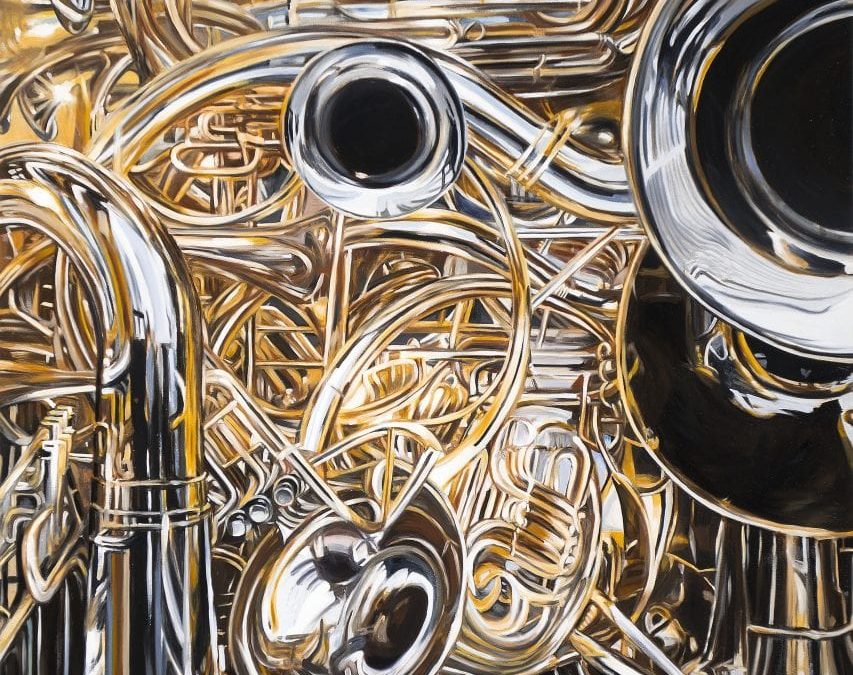Art: Cacophony by Allan Gorman, @allangormanart
ART FEATURE: ALLAN GORMAN
 You’ve self-defined your work as “abstract compositions nested in the guise of realism.” Can you say more on this idea that your art is more abstract than it is realistic?
You’ve self-defined your work as “abstract compositions nested in the guise of realism.” Can you say more on this idea that your art is more abstract than it is realistic?
A number of years ago, while driving in the rain, I found myself stuck behind a few big 18-wheelers on a back road. No way around them, and the wake from the mud flaps kept splashing on my windshield. It was a bit claustrophobic and scary. I was actively searching for something good to paint, and so had the thought: “maybe I could capture that feeling of claustrophobia in a painting?” I tried. But since I was only working from sense memory (couldn’t take any reference photos while driving), it wasn’t a very good painting–not something I would show anyone. But that sparked the idea of big trucks as an interesting subject for painting. I would run around truck stops looking for ideas and taking reference photos and became fascinated with the reflections and designs made by the chrome and structural parts over the actual truck itself. That started a journey of exploring the geometries and tensions created by the shapes of machined objects and the positive and negative spaces.
Since then, my work has continued to evolve and I’ve come to understand that what I choose to depict aren’t the objects per se, but rather the drama that I find within — or created by — those objects. I like to say that “I’m not painting a picture of a thing, I’m painting the dance.”
Tallest Train Station in NYC
What aspects of your long-time career in marketing do you think prepared you for your career as an artist?
It certainly helped me understand the difference between the making of art and the selling of art – which are two totally unrelated endeavors.
Forty years in the marketing business led me to understand that for a brand to be successful, it needs to be perceived as a more attractive alternative for the people who engage with it. In other words, you have to find out what might make the customer think “it’s better over there – I really want that!” Following that logic, if you want to succeed commercially as an artist, you might want to do research into what could make a potential customer love your art, and then make art to address their desires. But then, even if you make more money, you’d just be making commercial art. And I don’t believe that’s the reason why artists create art.
As an artist, I think you need to define success on your own terms – not on what you think a customer or a gallery might like. As I mature, I care less and less about what others may think, and simply try to challenge myself to grow with each new effort. If people like it, that’s great. If they don’t, that’s okay too. The important thing is, did I give it my best shot? If the answer is “Yes!”, to me that’s success. These days, I’m doing the best work I’ve ever done, and am happier than I’ve ever been.
Z Line Zs
Can you tell us about your artistic process and mediums, and specifically about how you use the camera as a tool?
When I’m working on a series of paintings, I establish certain criteria to define what the series will be about. I’ve just started a new body of work that will push abstract compositional elements more than I have before by combining large, formal flat fields of color as a design element, juxtaposed against realistically rendered pictorial areas. (See: “Shadows on the Lobby Wall”)
Once I’m fixated on an idea, I’ll constantly be on the lookout for things that I’ll be able to photograph and use in a new painting. I’ll take hundreds of shots. Then edit and compose my “blueprint” on the computer to create and print out a mock-up of what the final painting will look like.
When it’s time to paint, I project the image onto the support of my choice. The size will be determined by what feels right for the composition, not necessarily by the confines of a pre-determined, off-the-shelf size. For bigger works, I’ll work on un-stretched linen, taped to a flat wall. I’ll mount them later – after they’re dried and varnished.
Shadows On The Lobby Wall
Your ability to find beauty in subjects whose artistic value is often overlooked seems to be one of your defining characteristic as an artist and as a person. What has your experience been with encountering art in the places you least expect it? Do you think any other aspects of your life or your personality influence your ability to see beauty in the commonplace?
Can you tell us about your current exhibit at 350 Bleecker, NYC?
Manhattan Valley Overpass
What accomplishment or exhibition are you most proud of, and why?
Pigeon on a Rusty Girder
What advice do you have for aspiring artists trying to navigate the art world for business opportunities?
What would you most like for people to take away from viewing your art?






